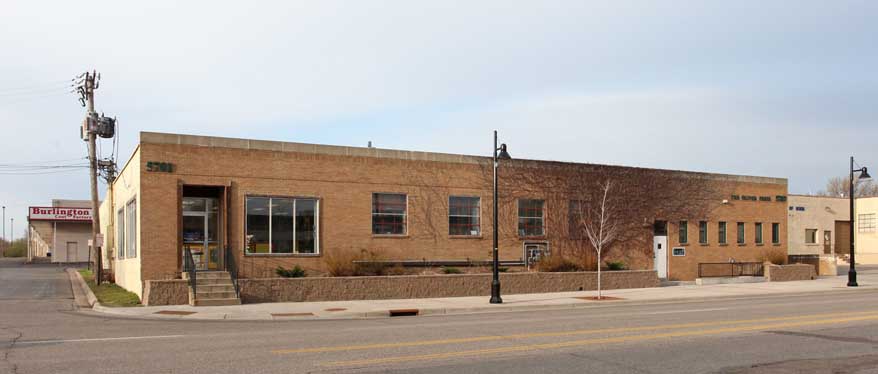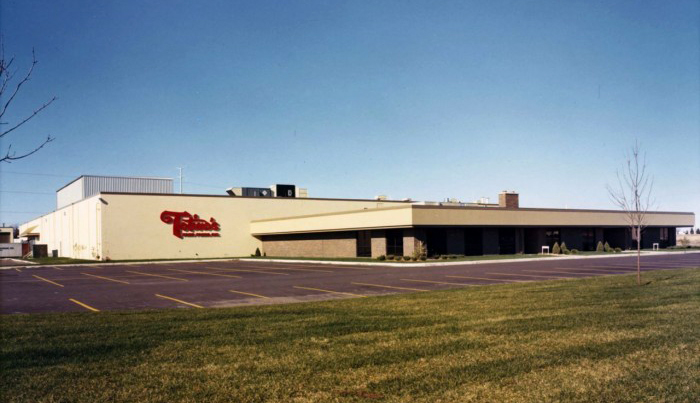This page deals with 36th Street between Excelsior Blvd. and Alabama Ave.
WEST OF HIGHWAY 100
West 36th Street, between Highway 100 and Wooddale, is just a short stretch of road, but it has undergone many changes over the years. Although surrounded by industry and retail, it appears to have started out as a residential area. There were several houses, some dating back to the 1920s, lining the streets. Other houses were built in the 1940s and ‘50s.
One of these houses was the family home of Charlie Brown, the namesake of Charles Schulz’s cartoon character. The area was still pretty wide open – the land that would become Shoppers’ City was still vacant, and the land north of 36th, behind the houses, was used as a refuse dump by the Minnesota Tree Service.
In 1946 blacktopping of 36th Street was delayed because residents were afraid that Friedheim’s trucks would cover it up.
Things started to change in about 1949, when Minnesota Rubber started building its compound in the area. Then starting in about 1951 there was a building boom of sorts. It was then that the residents complained, and requested clarification of the zoning of the area. Turns out that 36th Street was zoned light industrial in 1932. It was rezoned multiple dwelling in 1947, but then went back to light industrial in 1952.
Addresses of buildings built in or shortly after 1951 on are listed below: (Bolded and Italicized addresses indicate the legal address of a multi-address building.)
5600, 5650: Hoigaard Village, 2007
5605 (Formerly VFW/American Legion): 1954 – now demolished
5610-16: 1952
5618: 1952 (demolished)
5624-26: 1959
5700-02-04-06-08-10: 1960. One occupant in 1969-70 was the Youth Help Center, aka Youth Problem Solving Agency, run by Bud Larson. One former teen remembers it as a place for kids to hang out on couches (or make out on mattresses).
5701-11: 1953. Jerry Holt built this building. It (like the rest of the street) had probably been zoned residential; in 1952 it was rezoned light industrial, but the Village Council required that the building had to be stucco on the east and south sides, and brick on the north. In 1956 the F.M. Wolfe Co. made Wolfe Salad Dressing here.

TOTINOS
Rosenella Winifred Cruciani “Rose” Totino (January 16, 1915 – June 21, 1994) and her husband, Jim (1911 – 1981), founded a take-out pizzeria at 514 Central Ave. Minneapolis in 1951. They later expanded it to a full-service restaurant. Totino’s grandson Steve Elwell bought the restaurant in 1987 and moved Totino’s Kitchen from its original location in August 2007 to a new location in Mounds View. The new location closed in 2011.
In 1962 the Totinos also founded a frozen-pizza manufacturing company in St. Louis Park. Many Park High students worked at the 36th Street location after school – and smelled like Pizza!
The company moved the plant to larger quarters in Fridley in 1971.

In 1975, the Totinos sold their frozen pizza business to the Pillsbury Company for $22 Million in Pillsbury stock. Totino’s was the world’s largest frozen pizza company in the 1970s. Rose Totino was named as Vice-President at Pillsbury, in charge of advertising and publicity for the Totino’s brand. She was the first female Vice President at Pillsbury, and was elected into the Frozen Food Hall of Fame and the Minnesota Inventors’ Hall of Fame.

The Totino’s brand was acquired by General Mills with its purchase of Pillsbury.
5718: Vacant land
5721: 1956
5724: 1951
5727: 1959
5801-5807
5802-04-06-08-10-12: 1951. 5808 was the address of the Clothing Distribution Center, a/k/a C&R Clothiers.
5814, 5816: Vacant Land
5825: Vacant Land
6210: The Dari Vi was an ice cream and BBQ beef place owned by Vincent Ryan. Although the address is on 36th Street, it may have actually faced Highway 7, across from Central.
IMPROVEMENTS
W. 36th Street from Highway 100 to Wooddale was improved in 1977. Mayor Irv Stern and Councilmen Len Thiel and Keith Meland attended the August ribbon cutting.
In May 2011, Mayor Jeff Jacobs cut the ribbon to dedicate artwork that had been installed on 36th Street between Highway 100 and Wooddale Ave. The artist, Marjorie Pitz, placed pieces that look like little people along the sidewalk, with benches that look like reclining bodies. With the Hoigaard Village development, the installation is intended to reflect a return of people to the street. Ironically, the street had been residential, with houses dating from the teens and ‘20s, before they were razed in the ‘50s to build the commercial and industrial buildings that are there now. Fun fact: the “real” Charlie Brown was a resident of the Old 36th St. The artist describes them this way:
The inspiration for the body benches and body bollards is to begin to “people” the street. The City wishes to convert 36th St. from an industrial strip to a vibrant people street with housing and shops. Putting sculpted people on the street now, during the transition, makes a statement that the street is catering to people now, not to industry. The bodies are intended to provoke and intrigue drivers, and make them slow down or stop sometime to engage. The bodies are abstracted, non-literal and non-sexual to allow people to interpret them as they wish. They are supposed to serve as benches and bollards in a practical, but light-hearted way.
While some of these buildings have been recently updated, others have met the wrecking ball in conjunction with the redevelopment of the Minnesota Rubber plant and Hoigaard’s. There is also the possibility of a light rail station to be located at 36th and Wooddale. 36th Street seems to be in a constant state of flux, and its future remains to be seen.
EAST OF HIGHWAY 100
36th Street east of Hwy 100 (then known as Highland Ave.) was improved in the spring of 1911. The route went through the farm known as Westmoreland Park, owned by Mr. Tilney, for which he was paid either $100 or $600. Westmoreland was the name for Princeton Ave.
In 1912 John A. Goodrich requested that the Village put Highland Ave. from Excelsior to Pleasant (36th St. between Excelsior and Wooddale) “in good condition for travel.”
Again in 1913, Ora Baston petitioned the Council to put Highland Ave. from Railway Ave. (no such street?) to Excelsior Blvd. “in a good condition for use.”
The road from 100 to Raleigh was blacktopped on June 15, 1953.
36th Street east of 100 seems to have been populated with scattered houses at one time. When Friedheim and Jacobson petitioned the City Council to change the zoning of the area that would become the Beltline Office Park from Open Development to Light Industrial, a resident at 36th and Raleigh complained. This was in 1955.
In December 1954 developer Sam Clyman wanted 36 ½ Street to be renamed 36th Lane, but was denied.
In 1970 the Fire Department burned structures adjacent to Wolfe Park.
Wolfe Lake Professional Center – 5000 West 36th Street
5100 West 36th Street – Post Office
36th STREET BRIDGE
The intersection of 36th Street and Highway 100 was a busy one, and the the City Council allotted $9,000 for a traffic signal to be installed. A hand operated signal was to be used until the permanent one could be installed. In 1985, a bridge took traffic over Highway 100, eliminating one of the last stoplights on Highway 100.
The section between Belt Line Blvd. and Excelsior Blvd. was renamed Monterey Drive. After it crosses Excelsior Blvd., it becomes 38th Street.
